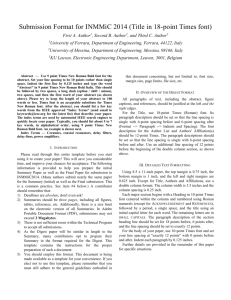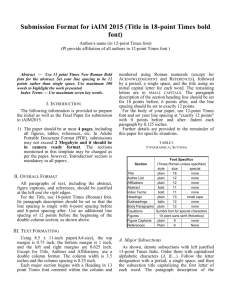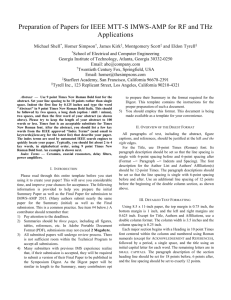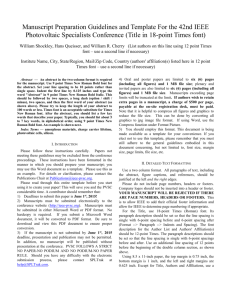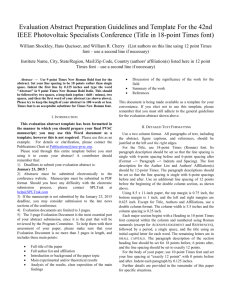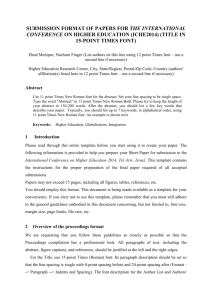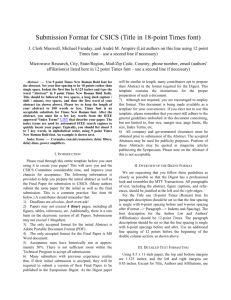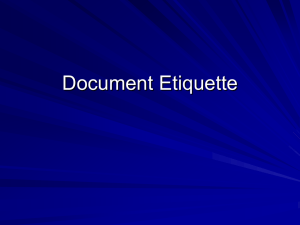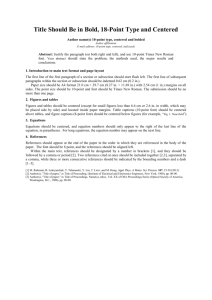Word Template
advertisement
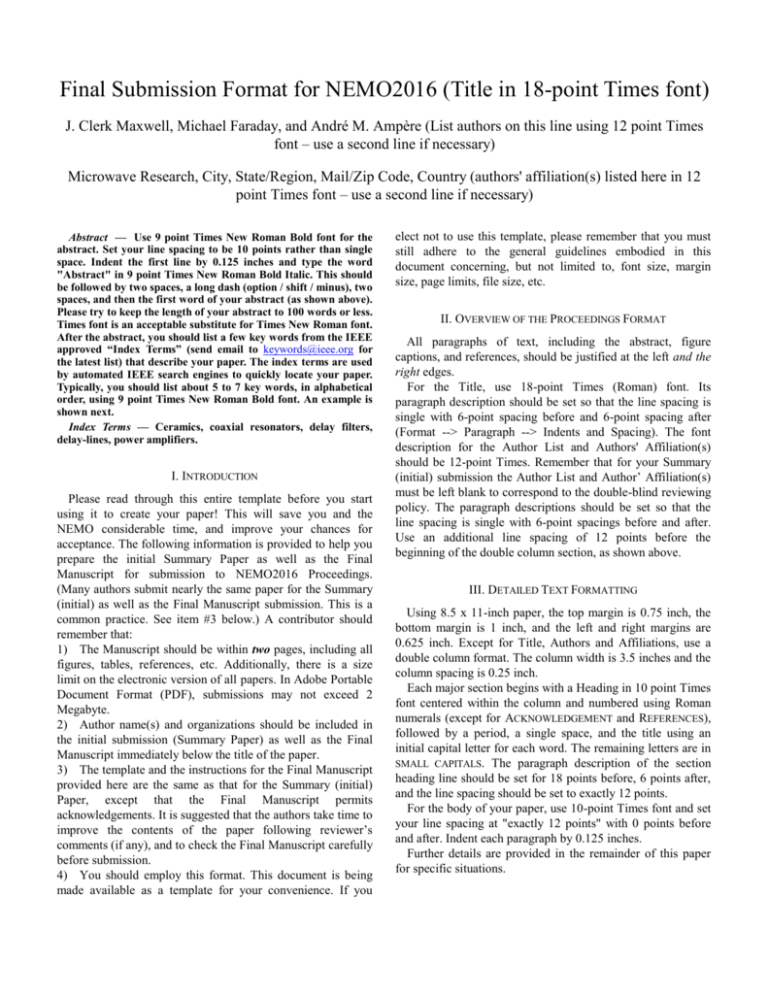
Final Submission Format for NEMO2016 (Title in 18-point Times font) J. Clerk Maxwell, Michael Faraday, and André M. Ampère (List authors on this line using 12 point Times font – use a second line if necessary) Microwave Research, City, State/Region, Mail/Zip Code, Country (authors' affiliation(s) listed here in 12 point Times font – use a second line if necessary) Abstract — Use 9 point Times New Roman Bold font for the abstract. Set your line spacing to be 10 points rather than single space. Indent the first line by 0.125 inches and type the word "Abstract" in 9 point Times New Roman Bold Italic. This should be followed by two spaces, a long dash (option / shift / minus), two spaces, and then the first word of your abstract (as shown above). Please try to keep the length of your abstract to 100 words or less. Times font is an acceptable substitute for Times New Roman font. After the abstract, you should list a few key words from the IEEE approved “Index Terms” (send email to keywords@ieee.org for the latest list) that describe your paper. The index terms are used by automated IEEE search engines to quickly locate your paper. Typically, you should list about 5 to 7 key words, in alphabetical order, using 9 point Times New Roman Bold font. An example is shown next. Index Terms — Ceramics, coaxial resonators, delay filters, delay-lines, power amplifiers. I. INTRODUCTION Please read through this entire template before you start using it to create your paper! This will save you and the NEMO considerable time, and improve your chances for acceptance. The following information is provided to help you prepare the initial Summary Paper as well as the Final Manuscript for submission to NEMO2016 Proceedings. (Many authors submit nearly the same paper for the Summary (initial) as well as the Final Manuscript submission. This is a common practice. See item #3 below.) A contributor should remember that: 1) The Manuscript should be within two pages, including all figures, tables, references, etc. Additionally, there is a size limit on the electronic version of all papers. In Adobe Portable Document Format (PDF), submissions may not exceed 2 Megabyte. 2) Author name(s) and organizations should be included in the initial submission (Summary Paper) as well as the Final Manuscript immediately below the title of the paper. 3) The template and the instructions for the Final Manuscript provided here are the same as that for the Summary (initial) Paper, except that the Final Manuscript permits acknowledgements. It is suggested that the authors take time to improve the contents of the paper following reviewer’s comments (if any), and to check the Final Manuscript carefully before submission. 4) You should employ this format. This document is being made available as a template for your convenience. If you elect not to use this template, please remember that you must still adhere to the general guidelines embodied in this document concerning, but not limited to, font size, margin size, page limits, file size, etc. II. OVERVIEW OF THE PROCEEDINGS FORMAT All paragraphs of text, including the abstract, figure captions, and references, should be justified at the left and the right edges. For the Title, use 18-point Times (Roman) font. Its paragraph description should be set so that the line spacing is single with 6-point spacing before and 6-point spacing after (Format --> Paragraph --> Indents and Spacing). The font description for the Author List and Authors' Affiliation(s) should be 12-point Times. Remember that for your Summary (initial) submission the Author List and Author’ Affiliation(s) must be left blank to correspond to the double-blind reviewing policy. The paragraph descriptions should be set so that the line spacing is single with 6-point spacings before and after. Use an additional line spacing of 12 points before the beginning of the double column section, as shown above. III. DETAILED TEXT FORMATTING Using 8.5 x 11-inch paper, the top margin is 0.75 inch, the bottom margin is 1 inch, and the left and right margins are 0.625 inch. Except for Title, Authors and Affiliations, use a double column format. The column width is 3.5 inches and the column spacing is 0.25 inch. Each major section begins with a Heading in 10 point Times font centered within the column and numbered using Roman numerals (except for ACKNOWLEDGEMENT and REFERENCES), followed by a period, a single space, and the title using an initial capital letter for each word. The remaining letters are in SMALL CAPITALS. The paragraph description of the section heading line should be set for 18 points before, 6 points after, and the line spacing should be set to exactly 12 points. For the body of your paper, use 10-point Times font and set your line spacing at "exactly 12 points" with 0 points before and after. Indent each paragraph by 0.125 inches. Further details are provided in the remainder of this paper for specific situations. TABLE I SUMMARY OF TYPOGRAPHICAL SETTINGS Font Specifics (Times Roman unless specified) style size special Title plain 18 none Author List plain 12 none Affiliations plain 12 none Abstract bold 9 none Index Terms bold 9 none Headings plain 10 small caps Subheadings italic 10 none Body Paragraphs plain 10 none Equations Symbol font for special characters Figures 8 to 10 point sans serif (Helvetica) Figure Captions plain 9 none References plain 9 none Section Paragraph Description spacing (in points) alignment line before after single 6 6 centered single 6 6 centered single 6 6 centered exactly 10 0 0 justified exactly 10 0 0 justified exactly 12 18 6 centered exactly 12 6 6 left exactly 12 0 0 justified single 6 6 centered single 0 0 centered 10 0 0 justified 10 0 0 justified indent (in inches) none none none 0.125 1st line 0.125 1st line none none 0.125 1st line none none none, tab at 0.5 0.25 hanging A. Major Subsections As shown, denote subsections with left justified 10-point Times Italic. Order them with capitalized alphabetic characters (A, B,...). Follow the letter designation with a period, a single space, and then the subsection title capitalizing the first letter of each word. The paragraph description of the subsection heading is set to "exactly 12-point" line spacing with 6 points before and after. B. Equations Equations should be centered in the column and numbered sequentially. Place the equation number to the right of the equation within a parenthesis, with right justification within its column. An example would be C E dL B dS t (1) Note that a period is used to properly punctuate the previous sentence. It is placed at the end of the second equation. Make sure that any subscripts in your equations are legible and are not too small to read! When referring to an equation, use the number within parenthesis. For example, you would usually refer to the first equation as (1) rather than equation (1). If possible, use the Symbol font for all special characters, or better yet, use Equation Editor™ or MathType™. The paragraph description of the line containing the equation should be set for 6 points before and 6 points after. The paragraph spacing will need to be set to "single" rather than "exactly 12 point" so that the height will autoscale to fit the equation. IV. FIGURES Figures should utilize as much of the column width as possible in order to maximize legibility. Use a sans serif font, such as Helvetica or Arial. Helvetica and Arial are larger and much easier to read than Times. Using 8- to 10-point Helvetica usually results in a legible figure. Do not use any font smaller than 8-point! It must be legible. When referring to a figure, use the abbreviation Fig. followed by its number. Place figure captions directly below each figure. Use 9-point Times with the paragraph spacing set at "exactly 10 points". Set a tab at 0.5 inch. Type "Fig. #." (# is the numeral) then tab over to the 0.5 inch mark before beginning the text of the figure caption. Note that figure captions are always (left and right) justified, rather than centered, even if they are less than a single full line in length. See the captions for Fig. 1. Within Microsoft Word there are several options for placing figures within your paper. Often the easiest is to insert them between existing paragraphs allowing the figures to remain in that relative position. The paragraph description where the figure is inserted must be set to "single" spacing rather than "exactly 12 points" in order to allow the line to autoscale in height to display the entire figure. Some disadvantages of this approach are that you don't have total flexibility in placing figures, and that the figures will move as text is inserted or deleted in any part of the document before the figure. If you elect to use this approach, it is recommended that you nearly complete the editing of your text before inserting any figures. Remember to allow room for them, however. Then begin inserting figures starting from the beginning of your document. Do not lump all figures at the end of the paper! If you have difficulties with the titles on your figures, you can always elect to add in the titles as separate text boxes, rather than importing the titles with the graph. This is sometimes helpful in getting a lengthy vertically-oriented title to display correctly. Quality of Manuscript 1 10-point Helvetica Table I on the second page was inserted using "Insert", "Text Box", creating the text contained in Table I, and then formatting the text box using all the settings available under "Format", "Text Box...". Table I also serves as an illustration of one of the rare instances when the double column format requirement can be violated. 8-point Helvetica V. CITING PREVIOUS WORK 0.5 0 0 0.5 1 Time Spent Reading Instructions Fig. 1. Estimated relationship between the time an author spends reading these instructions and the quality of the author's digest article. Notice that prior to the graph, a single 12-point line is used to separate the preceding text from the graph. The equivalent of a blank line should exist between the bottom of the graph (the x-axis caption) and the figure caption. (In this particular case, there was no need to add a blank line between the x-axis label and the figure caption, because there was already adequate spacing provided by the image border.) After the figure caption, there should be a single 12-point blank line before the text resumes. More flexibility is obtained in inserting figures if you can place them exactly where you would like them to be on a page. This can be accomplished by inserting the figure, selecting the figure, and then choosing "Format Picture...". Various settings allow you to place the figure at an absolute position on a page; specify if the text is supposed to flow around the figure or if the figure should move with the text, etc. If you elect to let the text flow around the figure, then remember that you will have to insert a separate text box for the caption, otherwise the figure caption is likely to become separated from the figure. If you decide to use color traces in your graphical data, be absolutely certain that there is no ambiguity about your graphical information when printed on a B&W printer. When referencing a journal article [1], a conference digest article [2] or a book [3], place the reference numbers within square brackets. To simultaneously cite these references [1][3] use the format just demonstrated. The reference list is the last section and references are listed in the order cited. Use 9 point Times. The paragraph description is set for a line spacing of exactly 10 points with 0 point spacing before and after. A 0.25 inch hanging indention should be specified. References should be detailed. For journal articles, list all authors by initials and last name, the title of the paper in quotations (capitalizing only the first letter of the first word), the journal name in italics, the volume number, the issue number, the page numbers, and the date. Use the examples provided [1]–[3] as a guide. VI. CONCLUSION Following these instructions will improve the quality of your paper and the NEMO Proceedings. If you have comments, please contact one of the Steering Committee editors. ACKNOWLEDGEMENT The authors wish to acknowledge the assistance and support of the NEMO Steering Committee. REFERENCES [1] W. H. Cantrell, “Tuning analysis for the high-Q class-E power amplifier,” IEEE Trans. Microwave Theory & Tech., vol. 48, no. 12, pp. 2397-2402, December 2000. [2] W. H. Cantrell, and W. A. Davis, “Amplitude modulator utilizing a high-Q class-E DC-DC converter,” 2003 IEEE MTTS Int. Microwave Symp. Dig., vol. 3, pp. 1721-1724, June 2003. [3] H. L. Krauss, C. W. Bostian, and F. H. Raab, Solid State Radio Engineering, New York: J. Wiley & Sons, 1980.
